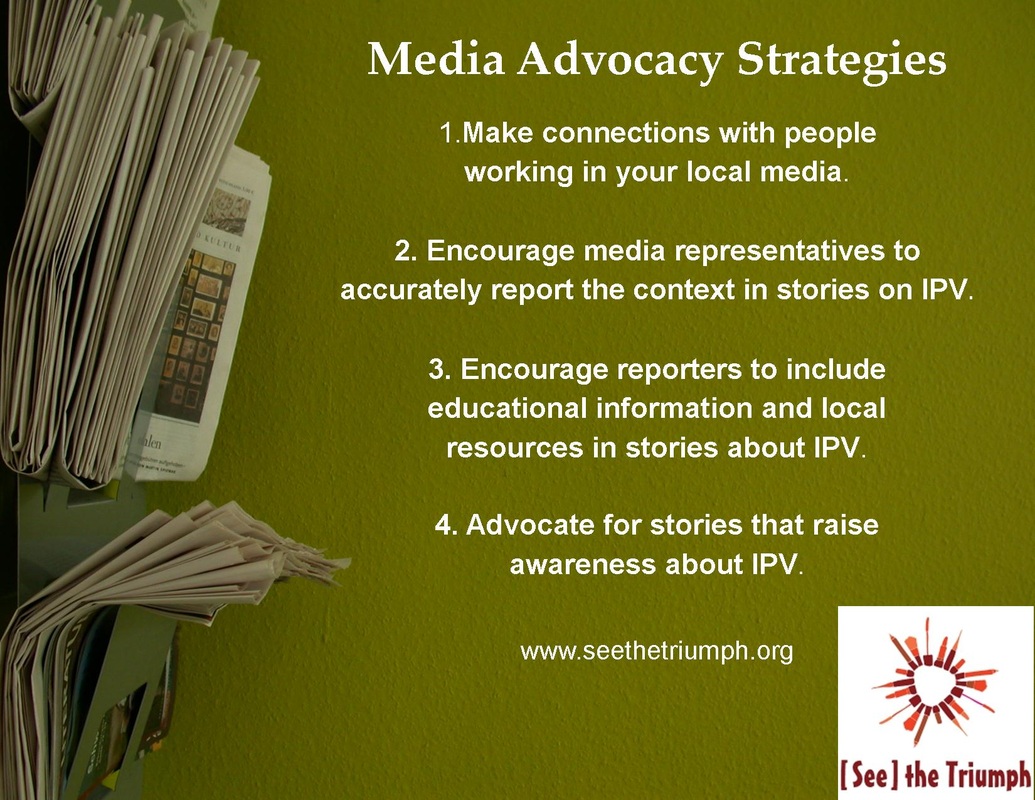|
By Christine Murray, See the Triumph Co-Founder
In part one of Intimate Partner Violence, Stigma, and the Media, I discussed how the news media can perpetuate stigma by the way it covers, or fails to cover, stories of intimate partner violence (IPV). I had the honor of working with a recent Masters of Public Health graduate, Brittany Brown, as well as my colleague Paige Hall Smith, on a study of media coverage in our local newspaper about IPV.(1) As part of this work, we learned about some strategies that advocates can use to work with local media organizations to help improve reporting of IPV-related stories. These strategies include the following: 1. Make connections with people working in your local media. If you have expertise on the subject of IPV, get to know local reporters and other media professionals so that they’ll know they can turn to you for information when stories arise. 2. Encourage media representatives to accurately report the context in stories on IPV. Sometimes, stories are written in a way that implies that the violence was spontaneous or an isolated incident. However, because IPV often occurs in a long-term pattern of power and control dynamics, providing information about this context, when available, helps to convey a more accurate portrayal of the dynamics of IPV. 3. Encourage reporters to include educational information and local resources in stories about IPV. When someone reads or sees a story about IPV in the media, this may lead them to recognize that they are in an abusive relationship, or that they know someone else who is. Therefore, reporters can provide a valuable service to the community when stories include contact information for local sources of assistance for survivors. In addition, educational information about warning signs of an abusive relationship can help people recognize when they or someone they know is at risk. 4. Advocate for stories that raise awareness about IPV. The media need not wait for tragic incidents to occur before they can report on the topic, and awareness-building pieces are valuable for informing community members about local IPV statistics and resources. Some story ideas may include stories of survivors who have overcome past abuse, coverage of professionals in the community who are working to support survivors and hold offender accountable, and local statistics, such as the number of calls to a local crisis line or to the police. Readers who are interested in learning more about reporting on IPV in the media can look the following web-sites for more information: Resources: (1) Brown, B., Murray, C. E., & Smith, P. H. (2013). Domestic violence representation in media: A toolkit for advocacy professionals. Poster presented at the UNCG Public Health Education internship poster session. Comments are closed.
|
Archives
July 2024
CategoriesAll About Intimate Partner Violence About Intimate Partner Violence Advocacy Ambassadors Children Churches College Campuses Cultural Issues Domestic Violence Awareness Month Financial Recovery How To Help A Friend Human Rights Human-rights Immigrants International Media Overcoming Past Abuse Overcoming-past-abuse Parenting Prevention Resources For Survivors Safe Relationships Following Abuse Schools Selfcare Self-care Sexual Assault Sexuality Social Justice Social-justice Stigma Supporting Survivors Survivor Quotes Survivor-quotes Survivor Stories Teen Dating Violence Trafficking Transformative-approaches |
Search by typing & pressing enter



 RSS Feed
RSS Feed